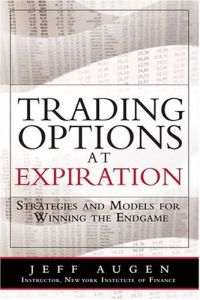Join getAbstract to access the summary!

Join getAbstract to access the summary!
Jeff Augen
Trading Options at Expiration
Strategies and Models for Winning the Endgame
FT Press, 2009
What's inside?
An investment expert explains how to profit from trading stock options just before they expire.
Recommendation
Investors commonly use pricing models and formulas to determine the fair value of call options to buy stock and put options to sell stock. But formulaic fair value does not account for all the pricing dynamics that affect options near their expiration dates. That is why the price of an expiring option often diverges from its fair value. This pattern of distorted pricing creates trading opportunities in the options market that are less risky and potentially more rewarding than holding the underlying stock over the long term. Jeff Augen’s compact, focused book details strategies for trading options on the third Thursday and Friday of each month, before the options expire that Saturday. He cautions that investors must be aware of collateral funding needs, regulatory requirements, investment minimums and other sophisticated details. Because Augen assumes that the reader has substantial background knowledge, professional traders may have the most to gain from his mathematically rigorous insights. getAbstract, which recommends books, but not investments (the opinions in the summary are those of the author), also suggests this book to amateur investors who are familiar with options and seek the next level of professional information.
Summary
About the Author
Jeff Augen is a private investor and an expert on information technology. He is an instructor at the New York Institute of Finance and the author of The Option Trader’s Workbook, The Volatility Edge in Options Trading and Bioinformatics in the Post-Genomic Era.
















Comment on this summary